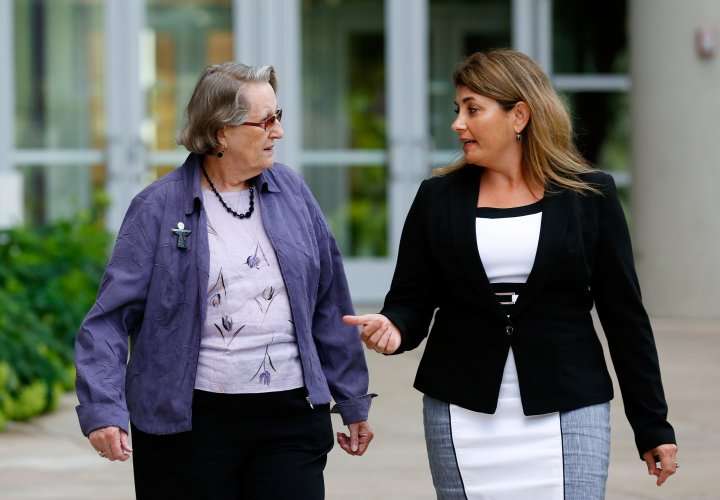Angela McArthur, right, director of the Anatomy Bequest Program at the University of Minnesota Medical School, walks with Jean Larson, widow of a donor, in Minneapolis on Aug. 11, 2016.
Angela McArthur, right, director of the Anatomy Bequest Program at the University of Minnesota Medical School, walks with Jean Larson, widow of a donor, in Minneapolis on Aug. 11, 2016. Andy Clayton-King—AP
A number of medical schools around the country have seen an increase in people donating their bodies to science after death.
Some institutions, including the University of Minnesota and the University at Buffalo, have seen the number of donated cadavers double in the last decade, the Associated Press reports. The reason for the spike seems to be twofold: The idea of allowing a loved one's corpse to be carved up is no longer as much of a taboo, and the cost of a traditional burial has increased. Many schools that use cadavers for medical research cremate the body when they are done and often return the cremains to the family at no cost.
When it comes to understanding the human anatomy and practicing surgical techniques, using a real human cadaver is infinitely more useful to medical students than plastic, rubber or virtual alternatives, experts say. "There's no substitute for the real thing, because ultimately these people are going to be taking care of patients," Dr. Michael Zenn, a surgery professor at Duke, told the AP. "It's just a priceless donation."

ScepticalChymist on August 12nd, 2017 at 00:44 UTC »
Gross anatomy in medical school was a profound experience. In the beginning, I didn't really think much about our cadaver and his past life. But one day during lab, out of nowhere, I was struck by the freckles on his arms from days spent in the sun. Had he been a farmer? Maybe he liked to spend his free time fishing in the sun with his grandkids with his sleeves rolled up. That moment when I came to grips with his humanity, I was overcome with gratitude, sadness, and respect. I do want to say that I'm proud of all my classmates. Throughout the dissection process, I saw nothing but professionalism and respect for the individuals that generously donated their bodies to our education.
After we finished our cadaver dissections, the remains were cremated and returned to the families. The med school held a ceremony and invited the donors' families. The anatomy professors gave speeches and students performed some musical pieces. The ceremony ended with a slideshow with a slide dedicated to each donor. Their families had sent in photos of their loved ones, and we finally learned their names. My group's donor looked like a pretty fun grandpa from the photos we saw.
The entire process was awe-inspiring and humbling, and still pause for reflection when I think about it.
TooShiftyForYou on August 11st, 2017 at 23:03 UTC »
Average cost of a funeral with burial in the US: $7,000 - $10,000
Average cost of cremation in the US: $1,500 - $3,000
Donating your body to benefit science - Free
Source
a-gay-canadian on August 11st, 2017 at 23:01 UTC »
Good. It benefits everyone. This is a great thing and should be advertised more often.